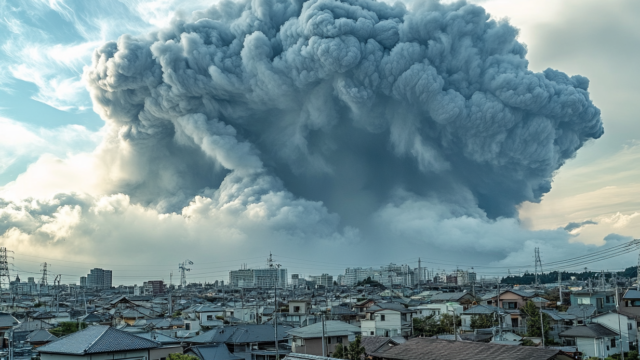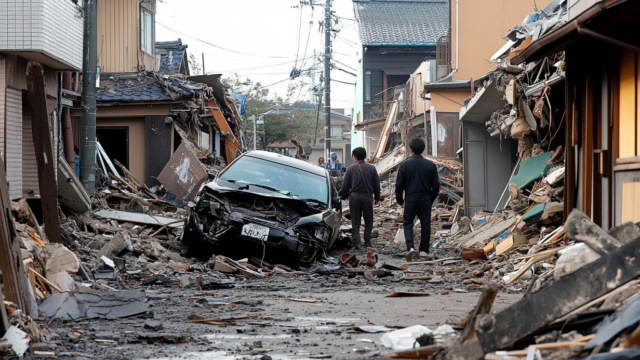
Solar Flares Erupt, Potentially Disrupting GPS and Satellite Communications
The Information and Communications Research Institute (NICT) announced that five large-scale solar flares erupted consecutively on the sun’s surface. The released corona gas may reach Earth, causing communication disruptions with satellites and increased GPS errors. The government anticipates potential two-week disruptions and significant transportation disturbances in the worst-case scenario. (49語)
日本語訳
「太陽面で大規模フレア5回連続発生、GPS・衛星通信に障害の恐れ」
情報通信研究機構(NICT)は、太陽の表面で大規模な太陽フレアが5回連続で発生したと発表した。放出されたコロナガスが地球に到達する可能性があり、人工衛星との通信障害やGPSの誤差増大などが懸念される。政府は最悪の場合、2週間程度の障害が生じ、交通機関に大きな混乱が生じる可能性を見込んでいる。

単語・熟語チェック
・solar flare 太陽フレア
・erupt 噴火する、爆発する
・consecutively 連続して
・corona コロナ、太陽大気
・disrupt 妨げる、混乱させる
・GPS(Global Positioning System) 全地球測位システム
・satellite 人工衛星
・communications 通信
・anticipate 予想する、予期する
・disturbance 混乱、障害
・worst-case scenario 最悪の事態を想定したシナリオ
単語解説
・solar flare
⇒太陽フレアのこと。太陽の表面で突発的に発生する大規模な爆発現象を指します。強力な電磁波やプラズマが放出され、地球の電離層に影響を与えることがあります。1859年の「キャリントン・イベント」は史上最大規模の太陽フレアとして知られ、当時の電信システムに大きな障害が生じました。
・erupt
⇒噴火する、爆発するという意味の動詞。eruptionが名詞形で、「噴火」「爆発」を表します。太陽フレアの突発的な発生を表現するのにふさわしい単語だと言えます。ちなみに、火山の噴火を表す際にもeruptという動詞がよく使われます。
・consecutively
⇒連続して、続けざまにという意味の副詞。consecutiveが形容詞で、「連続した」という意味です。ラテン語のconsequi(〜に従う)が語源で、sequenceと同じ語幹を持っています。5回のフレアが時間的に連なって発生したことを表しています。
・disrupt
⇒混乱させる、妨げるという意味の動詞。名詞形のdisruptionは「混乱」「中断」などの意味になります。ラテン語のdisrumpere(バラバラに壊す)が語源とされ、破壊的な変化を及ぼすニュアンスがあります。フレアによって通信システムが正常に機能しなくなる事態を指しています。
・disturbance
⇒混乱、障害、動揺などの意味がある名詞。動詞のdisturbは「かき乱す」「動揺させる」といった意味です。ラテン語のdisturbare(散らす)が語源で、秩序が乱されるイメージがあります。太陽フレアによって、交通機関に大きな混乱が生じる可能性について述べています。
原ちゃんチェック
太陽フレアによる影響は、現代社会のインフラにとって深刻なリスクになり得ますね。GPSや衛星通信は、私たちの生活に欠かせない技術となっているだけに、障害が生じれば大きな混乱は避けられないでしょう。
特に交通機関への影響は深刻だと思います。飛行機や船舶の運航管理、列車の運行管理など、GPSに大きく依存しているシステムが多いですから。物流の停滞なども懸念されます。
個人レベルでも、カーナビやスマホの地図アプリ、携帯電話など、日常生活に支障をきたすことになりかねません。
太陽活動の周期的な変動はある程度予測できるものの、個々のフレア発生のタイミングを正確に予知するのは難しいのが現状です。リスクを最小化するためにも、インフラの強靭化や代替手段の確保など、事前の備えを怠らないことが肝要だと感じました。
宇宙天気予報の高度化など、科学技術の発展にも期待したいですね。社会全体で危機管理の意識を高めていく必要性を感じるニュースでした。
関連URL
原田英語深堀りチェック
【太陽や太陽フレアに関する英単語や英語表現20】
1. Solar flare [太陽フレア] – A sudden, rapid, and intense variation in brightness on the Sun’s surface. (太陽表面の突然の急激で強烈な明るさの変化。)
2. Sunspot [黒点] – A temporary dark spot on the surface of the Sun, caused by intense magnetic activity. (激しい磁気活動によって引き起こされる太陽表面の一時的な黒い斑点。)
3. Coronal mass ejection (CME) [コロナ質量放出] – A massive burst of solar wind and magnetic fields released into space from the Sun’s corona. (太陽のコロナから宇宙空間に放出される太陽風と磁場の大規模な噴出。)
4. Heliosphere [ヘリオスフィア] – The region of space surrounding the Sun that is dominated by the solar wind. (太陽風が支配的な、太陽を取り囲む宇宙空間の領域。)
5. Sunrise [日の出] – The moment when the Sun appears above the horizon in the morning. (朝、太陽が地平線の上に現れる瞬間。)
6. Sunset [日没] – The moment when the Sun disappears below the horizon in the evening. (夕方、太陽が地平線の下に沈む瞬間。)
7. Solar wind [太陽風] – A stream of charged particles released from the Sun’s upper atmosphere. (太陽の上層大気から放出される荷電粒子の流れ。)
8. Prominence [プロミネンス] – A large, bright feature extending outward from the Sun’s surface, often in a loop shape. (太陽表面から外側に伸びる大きく明るい特徴で、しばしばループ状になっている。)
9. Solar eclipse [日食] – An event that occurs when the Moon passes between the Sun and Earth, blocking the Sun’s light. (月が太陽と地球の間を通過し、太陽の光を遮る現象。)
10. Photosphere [光球] – The visible surface of the Sun, from which most of its radiation escapes. (太陽の可視表面で、そこから太陽放射の大部分が脱出する。)
11. Chromosphere [彩層] – The layer of the Sun’s atmosphere above the photosphere, characterized by its reddish color. (光球の上にある太陽大気の層で、赤みがかった色が特徴。)
12. Corona [コロナ] – The outermost layer of the Sun’s atmosphere, visible during a total solar eclipse. (皆既日食の際に見える太陽大気の最も外側の層。)
13. Sunburn [日焼け] – Reddening, inflammation, and sometimes peeling of the skin caused by overexposure to the Sun’s ultraviolet rays. (太陽の紫外線に過度にさらされることによって引き起こされる皮膚の発赤、炎症、時にはむけること。)
14. Solar panel [ソーラーパネル] – A device that converts sunlight into electricity. (太陽光を電気に変換する装置。)
15. Sundial [日時計] – An ancient device that tells the time of day by the position of the Sun’s shadow. (太陽の影の位置によって一日の時刻を知ることができる古代の装置。)
16. Solstice [至点] – The time at which the Sun reaches its northernmost or southernmost point in the sky, marking the start of summer or winter. (太陽が空で最も北または最も南に達する時期で、夏または冬の始まりを示す。)
17. Solar cycle [太陽周期] – The periodic change in the Sun’s activity and appearance, lasting approximately 11 years. (約11年間続く太陽の活動と外観の周期的な変化。)
18. Helioseismology [日震学] – The study of the interior structure and dynamics of the Sun through the analysis of its surface oscillations. (表面振動の分析を通じて太陽の内部構造とダイナミクスを研究する学問。)
19. Solar maximum [太陽活動極大期] – The period of greatest solar activity in the solar cycle. (太陽周期における最も活発な太陽活動の時期。)
20. Solar minimum [太陽活動極小期] – The period of least solar activity in the solar cycle. (太陽周期における最も活動が少ない時期。)






